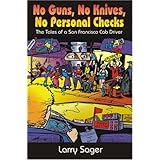
Average Reviews:

(More customer reviews)He eats Cheerios after getting home at 5:30 a.m. What no Maui Wowie? No London Iced Tea? He dutifully calls his girlfriend. Well, actually they aren't that friendly. (The girlfriend is an untold story.) He doesn't do anything or report on anything or do more than allude to anything but driving a cab. And he's very serious about the money. And the tips, and how to get them and how you can blow them off. He gives us the meter to the penny, and reports on the tip to the dime. But you can tell he really doesn't care. He worries about getting mugged and barfed on. He's patience and tolerant. But he's always smelling things. He looks for a dump in the backseat of his cab after some smelly guy has left. He can't find it. So he drives to a more lighted spot and searches some more. Nothing. Maybe he's losing it. His mind.
It's hard to tell at the beginning whether this is a memoir or a reportage. It reads like a string of closely related vignettes. But there is something holding it together. Hard to tell what it is. Except for the cab and The City and the derelicts and the poseurs and the transvestites and the drunks and the old people and the fat people and the night and the lights and the fear. Fear of guns and knives, or fear of being trapped in the job? He isn't sure. He tells himself he's driving a cab for the experience, to get material for The Novel. It's a sick world out there in the inner city. People are weird. He's taking notes and transcribing them when he gets home, turning it into Fiction.
He has a hero. Supercabman--himself. And he's a good hero, a cabbie psychologist and a wordsmith with a sharp satirical eye. He sizes people up, notes what they're wearing from their black leather pants to the grease spots on their shirts to their nose rings and bad teeth and bad breath and bad dye jobs, and how they are comporting themselves. Especially how they are comporting themselves. He has to. At three a.m. you don't want to make a mistake. Somebody's waving you down. Does he want a ride or your wad of bills? Hard to tell sometimes. Supercabman sees the city and it denizens without pity but then again with a minimum of judgment.
The cab's computer beeps messages. Sometimes he sends one himself. It sets off car alarms of nearby cars (ha, ha). He has his "cab policies." No smoking. That's tough. He pretends he's on the nicotine patch for commiseration. He has nicotine gum on the dash. Also pepper spray. (No plastic Jesus, though.) He knows how to small talk with the clientele and when Not to Ask and when to shut up. He's shrewd and cynical. Larry Sager is also one heck of a writer. Here's a bit from the "Safe Sex" chapter:
"Circling back and forth between a few different South of Market establishments finally turns up some stragglers: three men coming out of a popular gay bar, THE STUD on Harrison Street. One guy, who could easily pass as a bouncer, is wearing a bright bleached white tank-top tee shirt emphasizing his steroid-induced muscular build--6'3" and at least 225 pounds. His two companions climb into the back seat. One guy could be a GQ model; his partner sports the escaped-convict look--head shaved, beard unshaven, dressed in a Goth black shirt and black pants. And someone, pray tell, has taken several sharp metallic objects and run them straight through his face. It looks painful, but doesn't seem to bother him. Of the group, I spotted him first and I wasn't going to stop. But when GQ playfully grabbed the metal-pierced escaped-convict's buttocks, and both seemed to enjoy the routine, realized they were together and figured they were a safe pick-up. If anyone looking like Thug is flagging me from a ragged street corner in the Tenderloin, I do NOT stop." (p. 99)
The real strength of the book is in the sharp observations that Sager's alter ego makes about his passengers and himself. A nice technique is for him say one thing and think another, or to reply directly in his head to something somebody has said, but not aloud, as in this exchange with a really, really BAD painter who has just shown him her canvas which he notes to himself is "hideous awful":
"I still have some touching up to do," she says, as if expecting to hear an objection
from me regarding her own "harsh" criticism.
How about touching it up with kerosene and putting a match to it?
"Oh," I nod instead, pursing my lips tightly. (p. 214)
There are some nice line drawings by Shanon Essex and one by Emil of some of the characters to grace the text. I think Sager might have intended this opus originally as journalism, but found as he wrote the improvised dialogue (both interior and exterior) and the flights of fancy he took with some of the characters, that this story of a time in his life was better told as fiction.
Finally I have to note that this IS a novel however episodically constructed, and a very clever and original one, because suddenly there is an ending that catches us by surprise. Suddenly there is a denouement in the last chapter as he lets a passenger take over his cab. Suddenly the novel is over and we see the point of all that has gone before. There are a few solitary whiskeys, a phone call to the offstage girlfriend, a bit of haziness and then the end to an experience.
Click Here to see more reviews about: No Guns, No Knives, No Personal Checks: The Tales of a San Francisco Cab Driver

0 comments:
Post a Comment